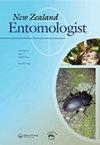纽西兰原生与外来膜翅目昆虫体型之比较
IF 0.4
4区 农林科学
Q4 ENTOMOLOGY
引用次数: 0
摘要
【摘要】体型是形态的基本组成部分,与许多生理和生态性状有关,并受到多种生物和非生物因素的影响。体型也可能对外来物种的形成有影响。我们比较了新西兰本土种、偶然引进外来种和有意引进膜翅目种的体型大小。采用新西兰节肢动物标本测量体长和前翼长度。采用线性混合效应回归模型比较不同生物状态组之间的总体体型,特别是属和科内物种之间的体型。共采集膜翅目昆虫740种2231份标本,其中本地种503种,外来种201种,防虫种36种。体长与前翅长呈极显著正相关(R2 > 0.97)。总体而言,物种的平均体型在本地和意外引入的外来物种之间没有显著差异,但故意引入的生物防治物种明显小于本地物种。外来种的体型差异大于本地种和生物防治种。在同一属或同一科中,本地种和外来种的体型没有显著差异。Levene’s检验表明,不同生物状态组间在属水平上差异相等,但在科水平上差异不相等。这项研究提供了一个关于关键形态特征——体型的大型数据集,可用于进一步研究形态如何被生态群落和物种之间的相互作用所塑造和影响。感谢Jessica McLay在编码和统计分析方面的建议。披露声明作者未报告潜在的利益冲突。本工作由商业、创新和就业部(MBIE)为Manaaki Whenua-Landcare Research的国家重要馆藏和数据库(NSCDs)资助。本文章由计算机程序翻译,如有差异,请以英文原文为准。
Comparisons of body size for native and exotic Hymenoptera established in New Zealand
ABSTRACTBody size is a fundamental component of morphology, related to many physiological and ecological traits, and is influenced by a variety of biotic and abiotic factors. Body size may also have a role in influencing the establishment of exotic species. We compared the body size of New Zealand native species, accidentally introduced exotic species, and deliberately introduced species of Hymenoptera. Specimens in the New Zealand Arthropod Collection were used to measure body and forewing length. Linear mixed effects regression models were used to compare the overall body sizes between biostatus groups, and specifically between species within a genus and family. A total of 2231 specimens were measured from 740 species of Hymenoptera, comprising 503 native, 201 exotic, and 36 biocontrol species. There was a strong positive correlation between body length and forewing length (R2 > 0.97). Overall, the average body size of species did not differ significantly between native and accidentally introduced exotic species, but deliberately introduced biocontrol species were significantly smaller than native species. Exotic species had greater interspecific variation in body size than either native or biocontrol species. There were no significant differences in the body sizes of native and exotic species within the same genus or same family. Levene’s tests revealed there was equal variance between biostatus groups at the genus level but unequal variance at the family level. This study provides a large dataset on a key morphological trait, body size, that can be used to further examine how morphology can be shaped by, and influence, ecological communities, and interactions between species.KEYWORDS: Ecological interactionsestablishmentinvasionlengthparasitoids AcknowledgementsThanks to Jessica McLay for advice on coding and statistical analysis.Disclosure statementNo potential conflict of interest was reported by the author(s).Additional informationFundingThis work was funded by the Ministry of Business, Innovation and Employment (MBIE) for Nationally Significant Collections and Databases (NSCDs) at Manaaki Whenua-Landcare Research.
求助全文
通过发布文献求助,成功后即可免费获取论文全文。
去求助
来源期刊

New Zealand Entomologist
ENTOMOLOGY-
CiteScore
0.70
自引率
33.30%
发文量
3
审稿时长
>12 weeks
期刊介绍:
The invertebrate diversity of New Zealand is of great interest worldwide because of its geographic isolation and geological history. The New Zealand Entomologist plays an important role in disseminating information on field-based, experimental, and theoretical research.
The New Zealand Entomologist publishes original research papers, review papers and short communications. We welcome submissions in all aspects of science regarding insects and arthropods in a New Zealand or Australasian setting. The journal’s subject matter encompasses taxonomy, phylogenetics, biogeography, biological control and pest management, conservation, ecology and natural history.
The journal is the official publication of the Entomological Society of New Zealand. Papers published or submitted elsewhere for publication will not be considered, but publication of an abstract or summary elsewhere (e.g. conference proceedings) does not preclude full publication in the New Zealand Entomologist. Accepted papers become copyright of the Entomological Society of New Zealand. The journal is published in English, but we also welcome publication of abstracts in Maori.
 求助内容:
求助内容: 应助结果提醒方式:
应助结果提醒方式:


